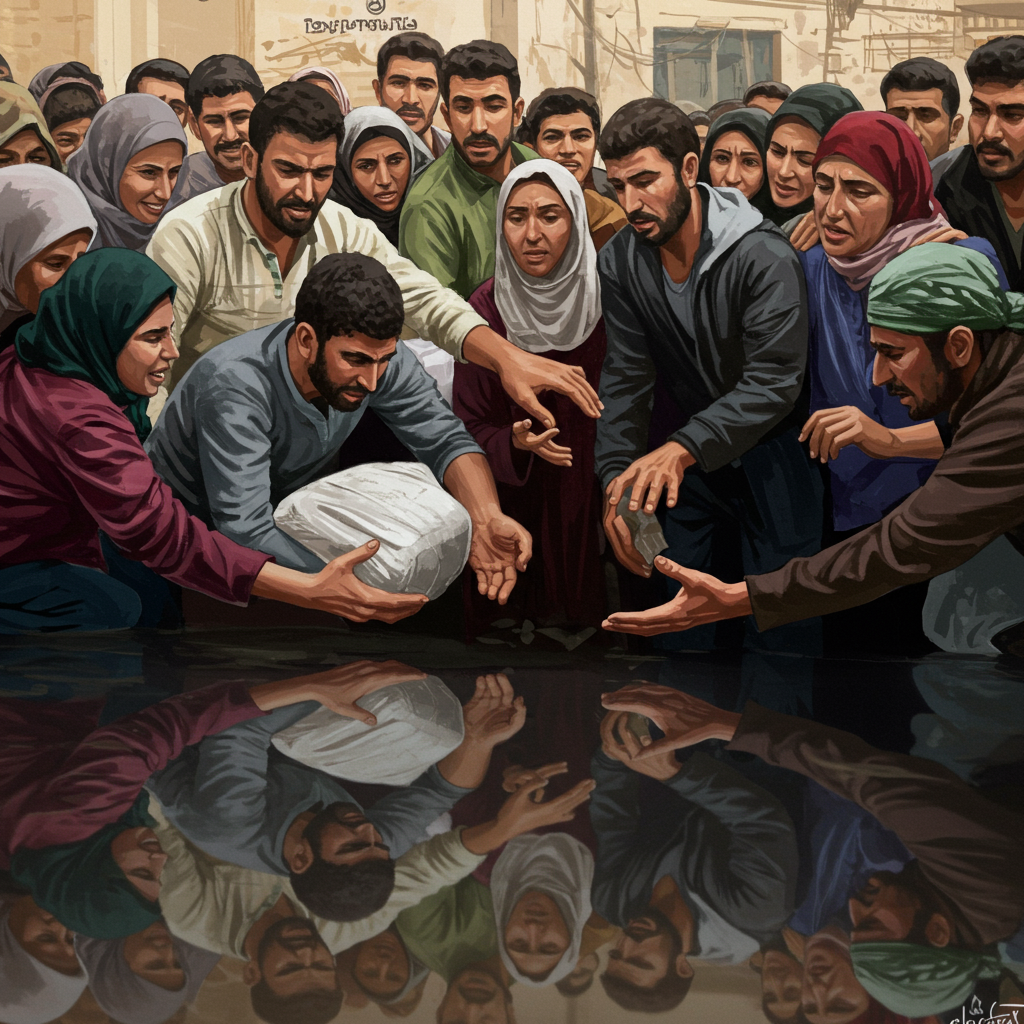Horrific reports have emerged from southern Gaza regarding multiple incidents near aid distribution points, detailing dozens of fatalities among desperate civilians attempting to access food. The situation underscores the severe humanitarian crisis gripping the territory and highlights the immense dangers faced by Palestinians seeking essential supplies. Competing accounts from witnesses, medical staff, the Israeli military, and involved aid groups offer drastically different narratives, complicating efforts to establish a clear picture of events in an area largely inaccessible to independent observers. This growing pattern of casualties near aid sites has drawn urgent calls for independent investigation from the international community.
Deadly Incidents Reported Near Gaza Aid Points
Specific reports detail tragic events. On a recent Saturday, Nasser hospital in southern Gaza stated that 24 people were killed near a site designated for aid distribution. Palestinians present at the scene placed blame on Israeli troops, claiming soldiers opened fire as crowds gathered to receive food. The Israel Defense Forces (IDF) issued a counter-statement, asserting they had “no known injured individuals” resulting from IDF fire near that specific location. Separately, an Israeli military official indicated that warning shots were discharged to disperse individuals perceived as a threat by their forces.
More recently, on a Sunday, multiple sources reported another deadly incident, this time near Israeli- and U.S.-supported aid sites in Rafah, in the southern Gaza Strip. Casualty numbers varied significantly across reports, with figures ranging from at least eight killed (according to NPR, citing health officials receiving bodies at Nasser Hospital) to over 50 killed (CBS News reporting 51 killed and over 170 wounded, citing the Hamas-run Health Ministry and witnesses). Another report cited at least 31 killed and 150 wounded (SAN.com, also referencing hospital staff). Witnesses described scenes of chaos and panic, with some calling the situation “a trap.” Accounts published by Reuters and the Associated Press featured witnesses describing gunfire erupting and people being shot in the head and torso. Some witnesses from the Sunday incident specifically reported fire coming from “all directions,” mentioning naval warships, tanks, and drones firing upon the crowds from a distance.
Conflicting Accounts and Lack of Verification
Establishing the precise sequence of events and responsibility remains challenging due to heavily contested claims. While witnesses and Palestinian health officials consistently accuse Israeli forces of opening fire on civilians seeking aid, the IDF has repeatedly denied its forces were responsible for the deaths near these sites. In response to the Sunday incident near Rafah, the IDF stated that its forces did not fire at civilians near or within the aid site, based on initial inquiries. The IDF has also previously acknowledged firing warning shots to disperse what they deemed threatening crowds but denied intentionally firing into masses of civilians.
Further complicating the narrative, the Gaza Humanitarian Foundation (GHF), the organization backed by the US and Israel operating the sites involved in the recent Sunday incident, denied reports of deaths, mass injuries, and chaos around its facilities, labeling them “false reporting.” GHF stated that its aid deliveries on the Sunday in question occurred “without incident.” The group also denied any outbreaks of gunfire directly at its installations and asserted its private security contractors have not fired on crowds. However, multiple witnesses have previously reported Israeli troops firing on crowds near GHF delivery sites during earlier distributions.
Crucially, claims from all parties – the Hamas-run health ministry, Palestinian witnesses, the IDF, and the GHF – have not been independently verified. A major barrier to independent confirmation is Israel’s restriction on access for international news organizations, including entities like the BBC, into Gaza. This lack of impartial access makes it extraordinarily difficult to corroborate witness testimony or official statements, leading to a situation where competing narratives persist without resolution.
The Crisis of Seeking Aid in Gaza
These deadly incidents are not isolated. There have been nearly daily reports of people being killed by Israeli fire while attempting to obtain food in Gaza. The struggle for survival is immense following months of conflict and severely restricted access to essential goods. Israel imposed a near-total blockade on aid deliveries in March, resuming its military offensive. While the blockade was partially eased in late May amid stark warnings of looming famine, severe shortages of food, medicine, and fuel continue across the territory. The UN agency for Palestinian refugees, Unrwa, reports daily increases in detected cases of malnutrition among thousands of children.
The humanitarian situation is compounded by changes to the aid delivery system. Alongside limited UN aid convoys, Israel and the US established the new Gaza Humanitarian Foundation (GHF) to manage distribution. They stated this system was intended to prevent the militant group Hamas from diverting aid. However, major UN agencies and international aid groups have refused to cooperate with the GHF system. They argue that it violates humanitarian principles, grants Israel undue control over who receives aid, and risks further mass displacement by concentrating distribution points.
Criticisms of the New Aid System
Concerns about the GHF-led system are significant. The UN human rights office recently reported a high number of aid-related killings, with 798 recorded up to a recent Friday. Notably, the vast majority – 615 deaths – occurred in the vicinity of GHF-operated sites. The remaining 183 killings were recorded near UN and other aid convoys. The GHF has disputed these statistics, accusing the UN of using “false and misleading” data sourced from Gaza’s Hamas-run health ministry.
Further allegations against the GHF system emerged when a former security contractor reportedly told the BBC he witnessed colleagues firing multiple times on hungry Palestinians who posed no apparent threat. The GHF categorically denied these specific allegations.
The transition to the GHF system has reportedly drastically reduced the number of aid distribution sites across Gaza, potentially from 400 under the UN system to just four concentrated points. This reduction, even after the ostensible easing of the blockade, concentrates risk and limits access, disproportionately affecting vulnerable populations like the elderly and people with disabilities who must travel long distances, often through heavily damaged areas, to reach these locations. The United Nations has warned that such privatized aid distribution systems located within military zones may expose civilians to greater danger and could potentially violate international law by effectively “weaponizing” food access.
Israel maintains that its stringent controls are necessary to prevent Hamas from siphoning aid, a claim the UN disputes, suggesting criminal gangs operating under the watch of Israeli forces may be more responsible for theft. The Israeli military has stated it acknowledges incidents where civilians have been harmed and is working to minimize “possible friction” between forces and the population.
Broader Conflict Context
These deadly incidents occur against the backdrop of the ongoing conflict that began with Hamas’ cross-border attack on Israel on October 7, 2023, which killed around 1,200 people and resulted in 251 hostages being taken. Israel’s subsequent military campaign in Gaza has led to widespread destruction and a devastating human toll. According to Gaza’s Hamas-run health ministry, at least 54,000 to 57,823 people have been killed in Gaza since October 7, with the majority reported as women and children. The conflict has also displaced around 90% of Gaza’s population, many multiple times. The struggle for aid, safety, and survival remains paramount for over two million people trapped in the besieged territory. The recent aid site incidents highlight the deadly confluence of severe deprivation and ongoing military operations, even amidst stalled ceasefire negotiations.
Frequently Asked Questions
What are the differing accounts regarding the recent deaths near aid distribution sites in Gaza?
Witnesses and Palestinian health officials, citing reports from locations like Nasser Hospital, state that dozens of civilians have been killed near aid sites, blaming Israeli forces for opening fire on crowds seeking food. The Israel Defense Forces (IDF) denies responsibility for these specific deaths, claiming their forces did not fire at civilians near the sites, though they have acknowledged firing warning shots at perceived threats. The Gaza Humanitarian Foundation (GHF), which operates some sites, also denies reports of deaths and chaos around its facilities as false. Independent verification of these conflicting claims is not currently possible due to restricted access for international media.
Where are the primary aid distribution points in Gaza located, and why are they controversial?
Under the new Gaza Humanitarian Foundation (GHF) system, the number of aid distribution sites has reportedly been drastically reduced and concentrated in a few locations, including points in Rafah. These sites are often situated within Israeli military zones. Critics, including UN agencies, argue this setup is controversial because it forces desperate civilians to travel long distances into potentially dangerous areas to access aid, increases risks by concentrating large crowds, and gives Israel significant control over the distribution process. UN and aid groups view this system as less effective and potentially more dangerous than previous methods.
Why are major international aid organizations reluctant to work with the new Gaza Humanitarian Foundation (GHF) system?
Major international aid organizations, including UN agencies like Unrwa, have largely refused to cooperate with the Gaza Humanitarian Foundation (GHF) system despite it being backed by the US and Israel. Their reluctance stems from concerns that the system violates humanitarian principles, primarily by giving Israel control over aid distribution which they fear could be used to influence civilian movement or access. They also argue the GHF system lacks the capacity and logistical reach needed to address the widespread hunger in Gaza, and that its location within military zones and reduced number of sites exposes civilians to unacceptable risks.
Conclusion
The recurrent pattern of deadly incidents near aid distribution points in Gaza paints a grim picture of a population facing extreme deprivation and peril. The conflicting reports from witnesses and official sources, coupled with severe restrictions on independent verification, underscore the challenges of documenting the humanitarian crisis accurately. The controversy surrounding the new aid distribution system, including its location in military zones and the concentration of risk at fewer sites, raises serious questions about the safety and efficacy of aid delivery under current conditions. As hunger deepens and casualties mount, urgent, impartial investigations are needed to establish facts and ensure accountability, alongside renewed efforts to facilitate safe, unimpeded access for humanitarian aid across all of Gaza.


